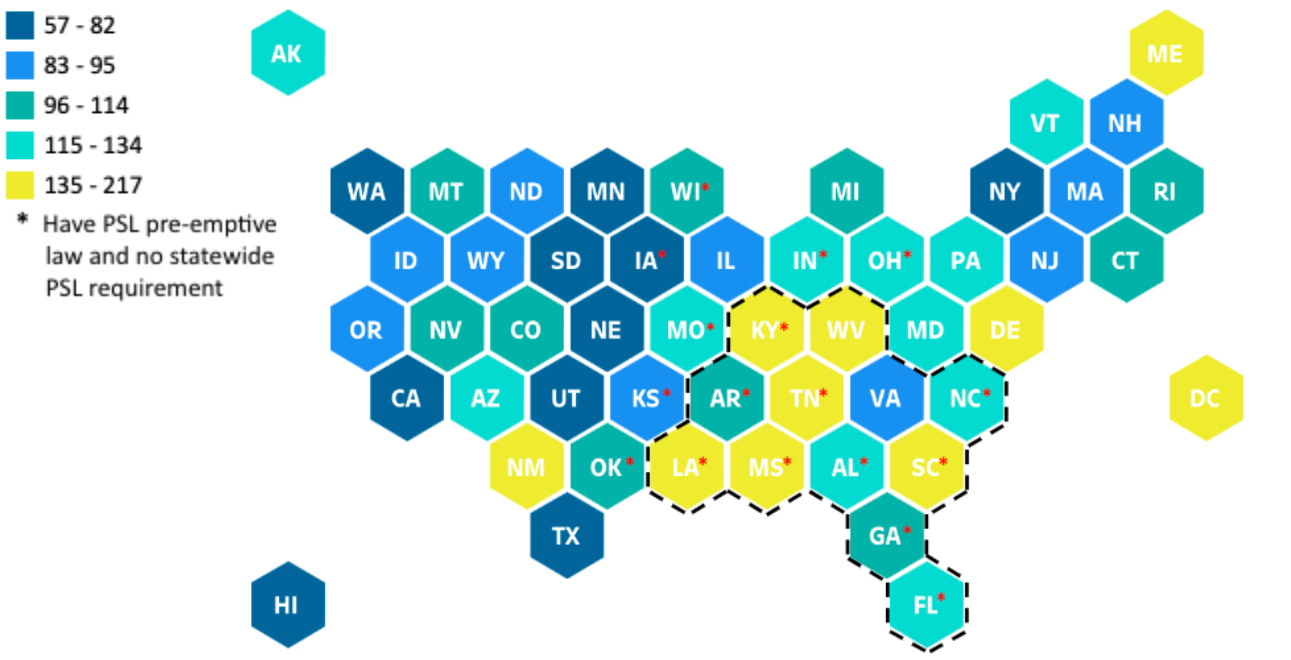Working-age Deaths and Paid Sick Leave
Working-age death rates from external causes were 33% higher in Southern states compared to non-Southern states.
Working-age deaths from external causes per 100,000 population, 2021
Population age 25-64
Source: CDC Wonder, NCSL, and EPI. Notes: PSL= paid-sick leave. External causes of death include: suicide (X66-X84, Y87.0), homicide (X86-X99, Y00-Y09, Y87.1), drug poisoning (X40–44, X60-X64, X85, Y10-Y14), acute alcohol poisoning (X45, X65, Y15), and transport accidents (V01-V99, Y85). Data is provisional and age-adjusted.
Since 2010, working-age mortality rates have been increasing, largely due to drug overdoses, alcohol poisoning, suicide, homicide, and traffic accidents (Motor Vehicle Deaths). In 2021, working-age death rates from “external causes” were 33% higher in Southern states than elsewhere in the U.S. Researchers have found that paid sick leave reduces deaths from these “external causes.”
The U.S. is the only wealthy country that does not mandate paid sick leave for workers.1 Paid sick leave reduces the spread of infections at workplaces and increases worker retention. Workers without paid sick leave are less productive and more likely to be injured at work. Moreover, workers without paid sick leave experience greater financial stress, and subsequently are more likely to overdose on drugs and to commit suicide.2,3 More than 35 U.S. cities or counties have passed paid sick leave ordinances, but several states have stepped in to outlaw such local ordinances.4 In 2010, only 1 state (Georgia) prohibited localities from mandating paid sick leave. By 2019, 23 states had passed laws that preempted localities from mandating paid sick leave.5 Every southern state (except Virginia and West Virginia) has preempted localities from passing paid sick leave ordinances and does not mandate it statewide — effectively prohibiting paid sick leave across the state.
“Contagion Nation 2020: United States Still the Only Wealthy Nation without Paid Sick Leave”. Rho, Fremstad, and Gaby-Biegel. Center for Economic and Policy Research. March, 2020. https://cepr.net/report/contagion-nation-2020-united-states-still-the-only-wealthy-nation-without-paid-sick-leave/#:~:text=Many%20mandate%20employers%20to%20cover,%2C%20and%20the%20United%20Kingdom).
“The Truth About Paid Sick Leave Law in the USA: The Good, the Bad, and the Ugly”. Factorial. November, 2021. https://factorialhr.com/blog/paid-sick-leave-law/#:~:text=Paid%20sick%20days%20dramatically%20reduce,may%20incapacitate%20many%20more%20employees.
“U.S. State Preemption Laws and Working-Age Mortality”. Wolf, Montez, and Monnat. American Journal of Preventive Medicine. August, 2022. https://www.ajpmonline.org/article/S0749-3797(22)00330-0/fulltext
“As More Cities Push for Paid Sick Leave, States Push Back”. Alvarez. Pew. September, 2018. https://www.pewtrusts.org/en/research-and-analysis/blogs/stateline/2018/09/24/as-more-cities-push-for-paid-sick-leave-states-push-back
“Workers’ rights preemption in the U.S.”. Economic Policy Institute. https://www.epi.org/preemption-map/

